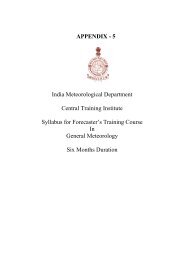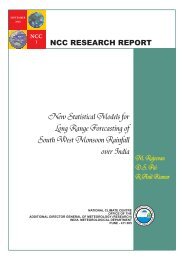BULLETIN OF IMSP - (IMD), Pune
BULLETIN OF IMSP - (IMD), Pune
BULLETIN OF IMSP - (IMD), Pune
- No tags were found...
You also want an ePaper? Increase the reach of your titles
YUMPU automatically turns print PDFs into web optimized ePapers that Google loves.
What causes lightning flashes to occur?C. U. UpadhyeIndia Meteorological Department, <strong>Pune</strong>Lightning is a spark, an avalanche of electrons rushing suddenly from one spot toanother, so fast and in such a quantity that they cause the air to glow.As water drops form and are blown upward in the center of a thunderstorm, mostfreeze into silvery ice crystals. They continue to rise accumulating more moisture, andgrow into mushy lumps of hail called grauple. Then they fall, bounce up, fall, blow upagain, accumulating more and more layers while supported in vertical winds so strongthey can lift hail as large as softballs.Each time the hail falls lower in the cloud it crashes into the rising crystals of ice,knocking off and collecting negative ions, and becoming negatively charged. The risingmist and ice crystals are left positive. Soon, the cloud top acquires an overall positivecharge while a hail and grauple produce a general negative charge at lower altitudes.When they build up, becomes strong enough electrons suddenly rush to the areaof positive charge, usually within the cloud or they may flash between clouds or evensideways into a cloudless sky.In a typical cloud-to-ground flash, as the cloud’s field changes, so do theelectrical characteristics of the ground under it. In at least 90 percent of cases, thenegative bottom of the cloud drives away negatively charged particles on the groundssurface, resulting in an overall positive charge there.A small, innocuous flow of free electrons begins between the earth and the cloud.Suddenly, the charge becomes large enough to break through insulating barrier of air.Electrons zigzag earthward at about 60 miles a second in what is called a “Steppedleader” each step perhaps 180 feet long (Nobody knows what it is stepped). It producesan ionized channel – molecules in the path are stripped of electrons an inch or so wide.The leader may split then split again. This stroke is not terribly potent; it carries perhapsonly 500 amperes or so and produces almost no light. When the negative leader reachesthe ground, small positively charged “connecting discharges” or upward streams” strikefrom upward projecting objects, tracks, steeples, golfers, and photographers in openfields touch metal tripods.When one of the streamers and leader meet, the circuit closes, a colossal returnstroke blasts upward at about half the speed of light and an average of 30,000 amperesthrough the leader tunnel. The air heats as high as 60,000 0 F (5 times the surfacetemperature of the sun) and its supersonic expansion produces a shockwave that becomesthunder.Things may stop there, but in most flashes after a pause, a “dart leader” using thestill hot channel zips down from the cloud (usually without the steps) and in turn triggersone or more subsequent return strokes.All the strokes back and forth each lasting about a millisecond-are what causeslightning to flicker.14
















